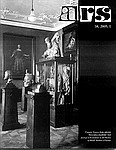
Časopis ARS 38 (2005) 1
Petra HANÁKOVÁ
Teoretické koncepty kritickej muzeológie[Theoretical Concepts of the Critical Museology]
(Resumé)
This study (originally an extensive part of the dissertation work) introduces, through the studies of key authors, and systematizes the most important lines of the theoretical critique of the museum (especially museum of art), of the last quarter of the century. One of the chapters/parts - "Foucault's inspiration of the recent museology" follows an influence of Michel Foucault on the present thinking about the museum, regarding especially two spheres of problems: the connection between power and knowledge (institutions of power and institutions of knowledge), and through so-called archaeology or archaeology of knowledge - conviction, that there is no knowledge not even the art historical knowledge, given once and forever, but all the time historical, ideological and institutional framed, thus in its nature changeable. An interest in the recent powerful museums of art inspired by the Foucault's critique is covered by this part of the text, a phenomenon of so-called museums of influence and their critical institutional history in the world context on one hand and in the regional scope on the other.
This part is followed by relatively tight zooming on the several museum studies of the American art historian Donald Preziosi, devoted to the deconstruction of the museum (of art) as an exemplary epistemological technology of Modernity and, also to the analysis of its main product - art (of art history) as a model paradigm, an important frame of references within the Modern knowledge.
The part entitled Feminist critique of museum of art is an effort to summarize the basic reproaches of the feminist critique against the museum of art (a male structure inherent to the basic, constitutive categories of the modern discipline, its survival and its "natural" influence on the canon of art history, etc.).
The last part of the study concerns the post-colonial critique of museum, the minority voice of the other cultures and their increasing interest in the adequate museum or exhibition representation. The example used here is the Mieke Bal's critical study on the colonial narrative strategies New York's Museum of Natural History. Relatively extensive part of text is then devoted to the European colonialism, the so-called - double-voice art history (Belting) and, on the related problem "what is to be done with social realism" in the museums of art in the "other" European countries.
English by Barbara Balážová